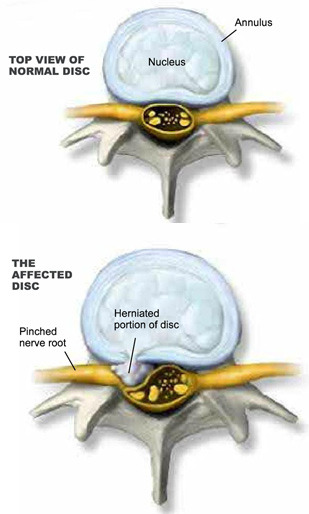 The lumbar spine consists of the five vertebrae in the lower part of the spine, each separated by a disc, also called a lumbar disc. The lumbar vertebrae are the biggest and strongest of the spinal bones. Certain movements can injure the discs in this part of the spine; bad posture, being overweight and disc dehydration that occurs with age.
The lumbar spine consists of the five vertebrae in the lower part of the spine, each separated by a disc, also called a lumbar disc. The lumbar vertebrae are the biggest and strongest of the spinal bones. Certain movements can injure the discs in this part of the spine; bad posture, being overweight and disc dehydration that occurs with age.
Risk of lumbar injury increases with each vertebrae down the spinal column because this part of the back has to support more weight and stress than the upper spinal bones. The lumbar disc is the most frequent site of injury in several sports including gymnastics, weightlifting, swimming and golf, although athletes in general have a reduced risk of disc herniation and back problems.
What to look for
Symptoms of disc herniation in the lower back are slightly different from symptoms in the cervical (link) or thoracic (link) parts of the spine. The spinal cord ends near the top lumbar vertebrae but the lumbar and sacral nerve roots continue through these spinal bones. A lumbar disc herniation may cause:
- Lower back pain
- Pain, weakness or tingling in the legs, buttocks and feet
- Difficulty moving your lower back
Problems with bowel, bladder or erectile function, in severe cases
Tests
Initial diagnosis of lumbar herniation generally is based on the symptoms of lower back pain. Your doctor will examine your sensation, reflexes, gait and strength
- X-ray
- CT scans
- MRI
- Nerve Injections (usually guided by x-ray to confirm correct placement)
Treatment
Conservative treatment of lower disc pain usually is successful over time. It includes:
- Pain medication or pain therapies such as ultrasound, massage or transcutaneous electrical nerve stimulation
- Anti-inflammatory medication such as paracetamol, NSAIDs
- Physiotherapy
- Steroid injections
- Education in proper stretching and posture
- Rest
However, if your pain doesn’t respond to conservative treatment in two to four weeks, your condition affects your bowel or bladder function, or if it threatens permanent nerve damage, your doctor may suggest surgery. Modern methods of surgery allow some spine operations to be performed through tiny incisions.
The surgery usually includes removing the part of the disc that has squeezed outside its proper place, called a Discectomy. The surgeon also may want to remove the back part of the vertebrae, called the lamina, in a laminectomy; or to surgically open the foramen, the holes on the side of the vertebrae through which the nerves exit, in a foramenotomy. Only about 10 percent of adult lumbar disc patients require surgery and even fewer children and adolescents.

